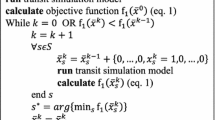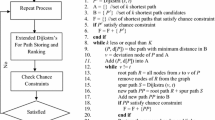Abstract
Semi-flexible transit (SFT) is commonly discussed as a cost-effective alternative to serving public transportation users in low-demand conditions. Despite its considerable potential, the implementation of SFT is limited due to two primary operating challenges: (a) fluctuating travel demand and (b) service unreliability. Most researchers recently are rigorously involved in developing complex algorithms and heuristics to handle operational planning issues, while very few focus on the optimization of variables for SFT operations involving tactical decision making. Moreover, the optimization of decision variables is largely based on a single dimension of stochasticity, demand only. The present study proposes a methodology to optimize two decision variables, service headway and the proportion of requests accepted for curb-to-curb service per trip while operating SFT following a route-deviation operating policy. Implementing stochasticity in both demand and vehicle arrival, we perform multi-objective optimization with two conflicting objectives as minimization of operator cost and user cost. Pertaining to vehicle delays and demand variability linked to values of decision variables in the Pareto set, we define the risks associated with selecting each value for attaining Pareto optimality. The risk is proportionate to the occurrence of a decision variable value in the Pareto set. The study methodology can be adopted as a decision support tool to establish planning policies to optimize SFT operation while considering the interests of both the operator and the user.







Similar content being viewed by others
Data availability
The data that support the findings of this study are not openly available due to privacy reasons and are available from the corresponding author upon reasonable request.
References
Alshalalfah BW (2009) Planning, design, and scheduling of flex-route transit service. Ph.D. thesis, University of Toronto
Ansari Esfeh M, Wirasinghe SC, Saidi S, Kattan L (2021) Waiting time and headway modelling for urban transit systems—a critical review and proposed approach. Transp Rev 41:141–163. https://doi.org/10.1080/01441647.2020.1806942
Babaei M, Schmöcker J-D, Khademi N, Ghaffari A-R, Naderan A (2016) Fixed-route taxi system: route network design and fleet size minimization problems. J Adv Transp 50:1252–1271. https://doi.org/10.1002/atr.1400
CUTA (2015) Canadian transit fact book 2015 operating data. Canadian Urban Transit Association, Toronto, Ontario, Canada
Daganzo CF (1978) An approximate analytic model of many-to-many demand responsive transportation systems. Transp Res 12:325–333. https://doi.org/10.1016/0041-1647(78)90007-2
Davison L, Enoch M, Ryley T, Mohammed Q, Chao W (2014) A survey of demand responsive transport in Great Britain. Transp Policy 31:47–54. https://doi.org/10.1016/J.TRANPOL.2013.11.004
Deb K (2001) Multi-objective optimization using evolutionary algorithms. Wiley, New York
Errico F, Crainic TG, Malucelli F, Nonato M (2013) A survey on planning semi-flexible transit systems: methodological issues and a unifying framework. Transp Res Part C Emerg Technol 36:324–338. https://doi.org/10.1016/J.TRC.2013.08.010
Errico F, Crainic TG, Malucelli F, Nonato M (2021) The single-line design problem for demand-adaptive transit systems: a modeling framework and decomposition approach for the stationary-demand case. Transp Sci 55:1300–1321. https://doi.org/10.1287/trsc.2021.1062
Estrada M, Salanova JM, Medina-Tapia M, Robusté F (2021) Operational cost and user performance analysis of on-demand bus and taxi systems. Transp Lett 13:229–242. https://doi.org/10.1080/19427867.2020.1861507
Fu L (2002) Planning and design of flex-route transit services. Transp Res Rec 1791:59–66. https://doi.org/10.3141/1791-09
Guenthner RP, Sinha KC (1983) Modeling bus delays due to passengers boardings and alightings. Transp Res Rec 915:7–13
Heilporn G, Cordeau J-F, Laporte G (2011) An integer L-shaped algorithm for the dial-a-ride problem with stochastic customer delays. Discrete Appl Math 159:883–895. https://doi.org/10.1016/j.dam.2011.01.021
Ho SC, Haugland D (2011) Local search heuristics for the probabilistic dial-a-ride problem. OR Spectrum 33:961–988. https://doi.org/10.1007/s00291-009-0175-6
Ho SC, Szeto WY, Kuo YH, Leung JMY, Petering M, Tou TWH (2018) A survey of dial-a-ride problems: literature review and recent developments. Transp Res Part B Methodol 111:395–421. https://doi.org/10.1016/j.trb.2018.02.001
Hyytiä E, Aalto S, Penttinen A, Sulonen R (2010) A stochastic model for a vehicle in a dial-a-ride system. Oper Res Lett 38:432–435. https://doi.org/10.1016/j.orl.2010.05.009
Kim M, Levy J, Schonfeld P (2019) Optimal zone sizes and headways for flexible-route bus services. Transp Res Part B Methodol 130:67–81. https://doi.org/10.1016/J.TRB.2019.10.006
Kittelson & Associates Inc, Parsons Brinckerhoff Inc, KFH Group Inc, Texas A&M Transportation Institute, Arup (2013) Transit capacity and quality of service manual, 3rd edn. The National Academies Press, Washington
Koffman D (2004) Operational experiences with flexible transit services, TCRP Synthesis 53. Washington, DC
Liu L, Sun L, Chen Y, Ma X (2019) Optimizing fleet size and scheduling of feeder transit services considering the influence of bike-sharing systems. J Clean Prod 236:117550. https://doi.org/10.1016/j.jclepro.2019.07.025
Mehran B, Yang Y, Mishra S (2020) Analytical models for comparing operational costs of regular bus and semi-flexible transit services. Public Transp 12:147–169. https://doi.org/10.1007/s12469-019-00222-z
Mishra S, Mehran B (2023) Optimal design of integrated semi-flexible transit services in low-demand conditions. IEEE Access 11:30591–30608. https://doi.org/10.1109/ACCESS.2023.3260727
Mishra S, Mehran B, Sahu PK (2020) Assessment of delivery models for semi-flexible transit operation in low-demand conditions. Transp Policy 99:275–287. https://doi.org/10.1016/j.tranpol.2020.09.004
Mohring H (1972) Optimization and scale economies in urban bus transportation. Am Econ Rev 62:591–604. http://www.jstor.org/stable/1806101
Pan S, Yu J, Yang X, Liu Y, Zou N (2015) Designing a flexible feeder transit system serving irregularly shaped and gated communities: determining service area and feeder route planning. J Urban Plan Dev 141:4014028. https://doi.org/10.1061/(ASCE)UP.1943-5444.0000224
Paquette J, Cordeau J-F, Laporte G, Pascoal MMB (2013) Combining multicriteria analysis and tabu search for dial-a-ride problems. Transp Res Part B Methodol 52:1–16. https://doi.org/10.1016/j.trb.2013.02.007
Potts JF, Marshall MA, Crockett EC, Washington J (2010) A guide for planning and operating flexible public transportation services. Transit Cooperative Research Program (TCRP), vol 140, pp 98. https://doi.org/10.17226/22943
Ruan M, Lin J (2009) An investigation of bus headway regularity and service performance in Chicago bus transit system. Paper presented at the Transport Chicago, annual conference
Smith BL, Demetsky MJ, Durvasula PK (2003) A multiobjective optimization model for flexroute transit service design. J Public Trans 6(1):81–100. https://doi.org/10.5038/2375-0901.6.1.5
Taylor BD, Miller D, Iseki H, Fink C (2009) Nature and/or nurture? Analyzing the determinants of transit ridership across US urbanized areas. Transp Res Part A Policy Pract 43:60–77. https://doi.org/10.1016/J.TRA.2008.06.007
Tirachini A (2014) The economics and engineering of bus stops: spacing, design and congestion. Transp Res Part A Policy Pract 59:37–57. https://doi.org/10.1016/j.tra.2013.10.010
Turnquist MA (1978) A model for investigating the effects of service frequency and reliability on bus passenger waiting times. Transp Res Rec 663:70–73
Vuchic VR (2005) Urban transit: operations, planning, and economics. Wiley, Hoboken
Wu W, Liu R, Jin W (2019) Designing robust schedule coordination scheme for transit networks with safety control margins. Transp Res Part B Methodol 93:495–519. https://doi.org/10.1016/j.trb.2016.07.009
Zhao J, Sun S, Cats O (2021) Joint optimisation of regular and demand-responsive transit services. Transportmetrica A Transp Sci 19:1987580. https://doi.org/10.1080/23249935.2021.1987580
Zheng Y, Li W, Qiu F (2018) A slack arrival strategy to promote flex-route transit services. Transp Res Part C Emerg Technol 92:442–455. https://doi.org/10.1016/j.trc.2018.05.015
Acknowledgements
The authors would like to thank the City of Regina for providing the data needed for this study.
Author information
Authors and Affiliations
Corresponding author
Ethics declarations
Conflict of interest
The authors declare that they have no conflict of interest.
Additional information
Publisher's Note
Springer Nature remains neutral with regard to jurisdictional claims in published maps and institutional affiliations.
Appendix 1: Properties of request arrival process/travel demand following a negative binomial distribution
Appendix 1: Properties of request arrival process/travel demand following a negative binomial distribution
The probability density function (PDF) of a negative binomial distribution (NBD) is characterized by a variance higher than the mean. The PDF of the NBD for a random variable X denoting the number of request arrivals (boarding/alighting) is expressed in Eq. (21). Further, the observed mean and variance are derived using Eqs. (22) and (23), respectively.
where X = number of failures preceding the rth success (i.e., number of request arrivals), r = number of zero arrivals, p = probability of success representing the probability of arrival, a = probability of a zero-request arrival at a stop in the interval ‘h’, b = probability of a non-zero request arrival at a stop in the interval ‘h’
The parameters a and r are a function of μ = sample mean (i.e., mean arrival rate), and s2 = sample variance (i.e., variance in request arrival pattern), as given in Eqs. (24) and (25), respectively.
Subsequently, considering a passenger request arrival pattern follows a NBD, the probability that a vehicle stops at a stop location is given in Eq. (26). Thus, for a low-demand route with n stops, the average number of times a transit stops for performing boarding and alighting operation E(s) along a route is as given in Eq. (27).
Rights and permissions
Springer Nature or its licensor (e.g. a society or other partner) holds exclusive rights to this article under a publishing agreement with the author(s) or other rightsholder(s); author self-archiving of the accepted manuscript version of this article is solely governed by the terms of such publishing agreement and applicable law.
About this article
Cite this article
Mishra, S., Mehran, B. Effect of stochastic vehicle arrival and passenger demand on semi-flexible transit design. Public Transp 15, 721–745 (2023). https://doi.org/10.1007/s12469-023-00325-8
Accepted:
Published:
Issue Date:
DOI: https://doi.org/10.1007/s12469-023-00325-8




